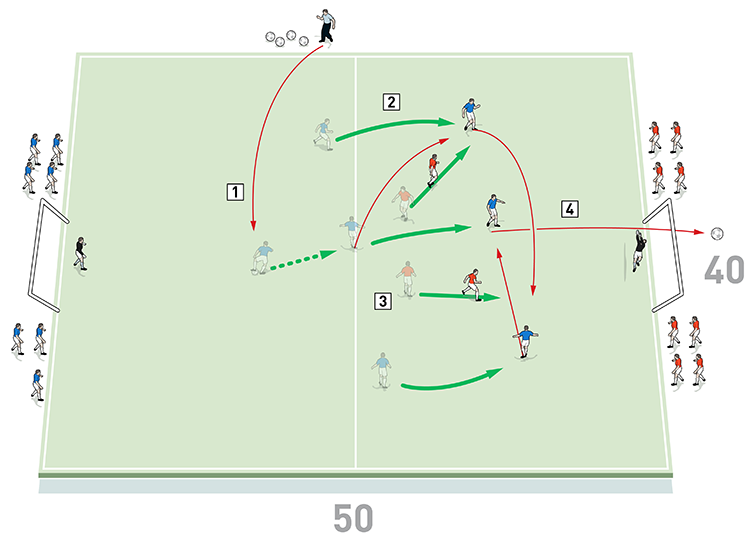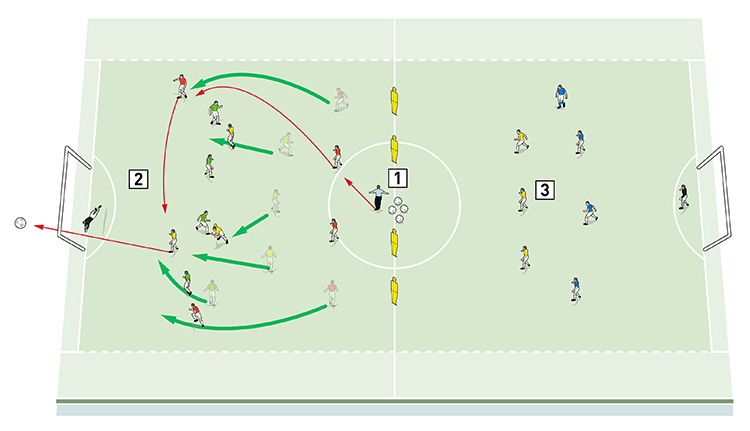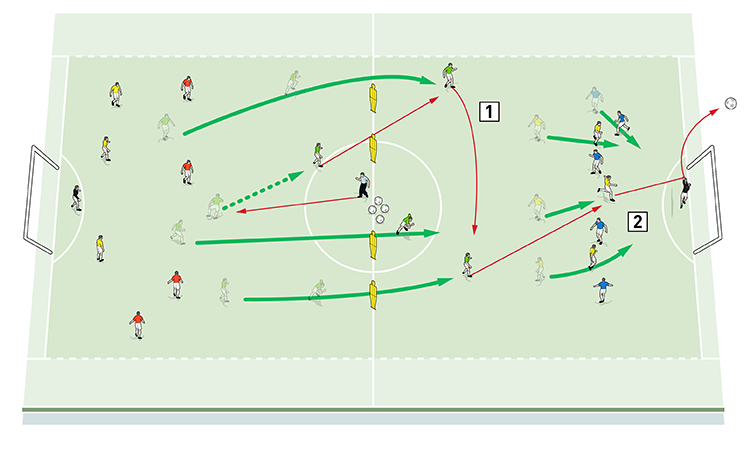You are viewing 1 of your 1 free articles
Counter-attacking
This session is aimed at counter-attacking the opposition, either from deep or from the middle third. It also focuses on exploiting attacking overloads. It’s a good training session because it caters for all positions and units.
| Area | Two thirds of pitch |
| Equipment | Balls, bibs, cones, 4 mannequins, 2 goals |
| No. of Players | 20 players + 2 goalkeepers |
| Session Time |
Transition wave game: 20mins, Counter-attacking waves: 20mins, 11v11 game: 20mins |
This session is aimed at counter-attacking the opposition, either from deep or from the middle third. It also focuses on exploiting attacking overloads. It’s a good training session because it caters for all positions and units.
These practices are all about attacking with speed and creating scoring chances. They will be used as part of a game plan in preparation for a specific match or we could use them as part of the periodisation of that week. High speed running and sprint distances are generally higher than normal when we run this type of session.
TRANSITION WAVE GAME
We set up an area of 50x40 yards with a goal and a goalkeeper at each end. We’re using 20 outfield players, split into two teams of 10. The players of each team start behind the byline at the end they are defending.
The coach starts play by serving the ball into one half of the pitch and three blue players enter from that end to receive and attack.
At the other end, two red players enter the pitch to defend. The blue attacking team go up against the red defenders in a 3v2 and try to exploit their overload to score, as shown [1a].
1a

2. Three blue players enter the pitch to receive the ball and attack
3. Two red players defend against the attack and if they win possession they should immediately counter-attack
4. The blue attacking team exploit their 3v2 overload to score in the goal
After the blue attack is dead, the last attacking player to touch the ball leaves the pitch and the two remaining players must now recover and transition to defend their goal. Three new red players enter the pitch from beside the goal and attack with a new ball served to them by the coach, as shown [1b]. Play continues in this manner as a 3v2 wave game, with players alternating the end of attack.
1b

2. The two remaining blue players must now recover and transition to defend their goal from the red attack that is about to start
3. The two defending reds leave the pitch and three new reds enter from beside the goal and attack the other end with a new ball served in by the coach
If the two defending players manage to win the ball, they should immediately counter-attack the opposition goal.
COUNTER-ATTACKING WAVES
We set up a playing area in the space between the two penalty areas of our usual pitch. We position a goal and a goalkeeper at each end and four mannequins along the halfway line.
We’re using 18 outfield players, split into three teams of four and two teams of three. A team of four starts at each end defending the goal at that end, while the remaining team of four starts from the centre of the pitch and attacks one of the goals. One team of three starts in each half and its players act as overload attackers.
The coach starts the practice from the centre by serving into the possession team, who must try to score in the goal using the help of the three overload players in that half. The overload players help to turn each attack into a 7v4 overload situation, as shown [2a].
2a

2. Three yellow overload players in that half help the possession team to attack, giving it a 7v4 overload. Here they exploit the overload and score
3. If the green defending team wins possession, they should counter-attack by passing through the mannequins and linking up with the three yellow overload attackers at the other end
As soon as the first ball is dead, the defending team receives a new ball and counter-attacks the opposite goal, passing through the mannequins and linking up with the three overload attackers at the other end, as shown [2b]. The defending team should also counter-attack in the same manner if they win possession of the ball from the attackers.
2b

2. The greens quickly counter-attack by passing through the mannequins and linking with the three yellow overload attackers at the other end
To progress this activity, in the moment when the defending team wins possession and the attack changes directions, we can also allow the three active overload attackers to quickly transition to defence, meaning they can now try to stop the defending team’s counter-attack by preventing the ball being passed through the mannequins on the halfway line.
We can progress this activity further by instructing the waiting defending team of four (at the opposite end to the first attack) to position two of its players on the halfway line, leaving them at a 3v2 disadvantage. When the counter-attack comes their way, the two defenders on the halfway line can only recover to defend once the ball has passed the mannequins on the halfway line, as shown [2c].
2c

2. Progress further by instructing the blue defending team to position two of its players on the halfway line. When the counter-attack comes their way, these two players can only recover to defend once the ball has passed the mannequins
We could also give the attacking team a time limit, allowing them just eight seconds to score from the point they cross the halfway line and if they succeed the goal is worth double. This encourages the players to attack quickly before the defenders can recover into a back four to stop the counter-attack.
How would I put this in a game situation?
We would finish with a game by turning the Counter Attacking Waves activity into an 11v11 game. The counter-attacking team should defend deep, while the other team attacks in numbers.
COACHING POINTS
What are the key things to look out for?
Tactically, we are looking for players to make specific overlapping or underlapping runs to exploit potential overloads. We want to see the players using good positioning while the team is still defending so they can quickly initiate a counter-attack.
We also want to see the team using good shape and a balanced attack, so if we can’t attack one side, we switch to attacking on the other side or centrally.
Technically, we want to see players winning the ball and playing a good first or second pass to start the counter-attack. We also want to see players recognising when to use penetrating passes to exploit overload situations.
Related Files
Editor's Picks
Deep runs in the final third
Using the goalkeeper in build-up play
Pressing principles
Intensive boxes drill with goals
Penetrating the final third
Creating and finishing
My philosophy
Pressing initiation
Compact team movement
Coaches' Testimonials

Alan Pardew

Arsène Wenger

Brendan Rodgers

Carlos Carvalhal

José Mourinho

Jürgen Klopp

Pep Guardiola

Roy Hodgson

Sir Alex Ferguson

Steven Gerrard
Coaches' Testimonials

Gerald Kearney, Downtown Las Vegas Soccer Club

Paul Butler, Florida, USA

Rick Shields, Springboro, USA

Tony Green, Pierrefonds Titans, Quebec, Canada
Join the world's leading coaches and managers and discover for yourself one of the best kept secrets in coaching. No other training tool on the planet is written or read by the calibre of names you’ll find in Elite Soccer.
In a recent survey 92% of subscribers said Elite Soccer makes them more confident, 89% said it makes them a more effective coach and 91% said it makes them more inspired.
Get Monthly Inspiration
All the latest techniques and approaches
Since 2010 Elite Soccer has given subscribers exclusive insight into the training ground practices of the world’s best coaches. Published in partnership with the League Managers Association we have unparalleled access to the leading lights in the English leagues, as well as a host of international managers.
Elite Soccer exclusively features sessions written by the coaches themselves. There are no observed sessions and no sessions “in the style of”, just first-hand advice delivered direct to you from the coach.









